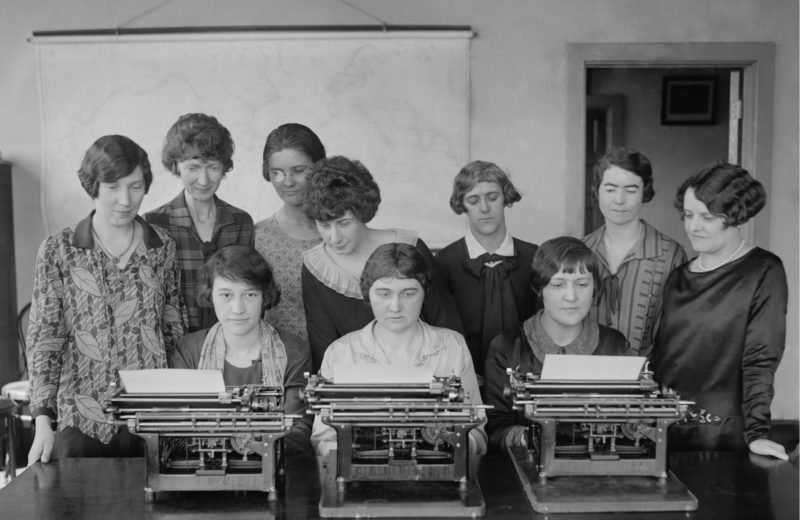Women in the Wonderful World of Work

March is Women’s History Month. It’s an opportune time to be asked, as I recently was, by a local women’s group to give a talk on “What Happens When Women Take Over.” My first reaction was, “In many ways, they already have!” But, of course, there is far more to the story that needs to be considered.
When one thinks about the topic, a number of hot-button questions surface. Still, the relatively recent gains made by women in the world of work paints a picture of meaningful change. Consider the female share of the workforce. In 1950, when the economy was still adjusting to the end of World War II and higher female labor force participation, 33.9 percent of work-age women were employed outside the home. Today, the share is around 57 percent.
What about other changes? That well-publicized wage gap between male and female pay? And how about the future outlook? What can we say about the prospects for women in the wonderful world of work?
In her scan of U.S. history, labor economist Claudia Goldin—a leading authority on the history of women at work—has identified several significantly different periods for female labor force participation. The first is from the late 19th century to the 1920s. During this period, mostly unmarried and uneducated women entered the workforce, either, for example, as piece-rate workers in textiles or garment manufacturing or as household help in other homes.
Married women, on the other hand, were heavily engaged in homemaking. There were lots of children, few if any labor-saving appliances, no fast food and no washing machines. Instead, there were scrub-boards and clothes to be dried in the sun. In rural areas, daughters routinely went to college to become equipped for teaching; meanwhile, their brothers stayed and farmed the land. By the 1920s some things had changed. More educated, married women began entering the labor force as teachers, nurses, and office workers.
Female labor force participation rose significantly from the 1930s to the 1950s, Goldin’s second period. It includes World War II and the replacement of men-gone-to-war by women in fields as diverse as manufacturing, construction, and mining. The world of work learned that “Rosie the Riveter” could perform as well or better than the men she replaced. It was also a period when female educational attainment rose significantly.
With growing work experience and more education, women workers prospered more during the next phase: the 1950s and 1960s. Office technologies advanced and, significantly, birth control became widely available. Access to education improved and major employment management changes occurred. All of these things made it possible for women to better manage their engagement with work. Married and single women began to fill better-paying, longer-term management positions.
With the coming of the 1970s, 1980s and beyond, dreams about future careers and work horizons changed significantly for young women. The percentage of women in the 25-to-64 age bracket in the labor force with a college degree more than tripled from 1970 to 2016, while roughly doubling for men. Previously closed employment opportunities were opened, marriage expectations and customs changed, and many past stereotypes regarding the role of women in society faded.
Even so, biology has always posed a work constraint for women who want to have children. Even in the most accommodating situations, childbirth can interrupt work and affect the promise and timing of advancements on the job. In some cases, women find themselves deciding whether to postpone having children, or even forgo having a family, in order to press on full-force with their careers.
What about wages, you may ask? In 1979, the first year for which solid data are available, women’s weekly earnings were 62 percent of men’s. In 2016, female earnings were 82 percent of male full-time workers, and the 82 percent rate has been stuck there since 2004.
Can the gap be closed further? Upon looking at the record since 1979, an optimist would say, “Sure. Give it some time.” One who is more pessimistic might look at the stalled pattern and say, “It will take lots of time to close.” Some suggest educational attainment is the answer. But it turns out that a wage gap is present at every level of educational attainment and gets larger as educational attainment increases.
Why might the gap widen with more education? There are multiple answers to the question, but the Economic Policy Institute suggested that the disproportionate gap is “affected by certain challenges that disproportionately affect women’s ability to secure jobs at the top of the wage distribution, such as earnings penalties for time out of the workforce, excessive work hours, domestic gender roles, and pay and promotion discrimination.”
All of this may stir some women to go into business for themselves, and it appears that is just what has happened. The number of U.S. businesses owned by women has increased by 114 percent over the last 20 years. According to the National Association of Women Business Owners (NAWBO), it stood at 11.6 million in 2017. For comparison, the total number of all businesses increased just 44 percent. NAWBO statistics show that about half those businesses are owned by women of color—Latina, African-American, and Asian-American. We may one day look back and identify this as the way in which the seeds of equal prosperity took root.
There’s another category to consider: What are the prospects for the professions? Law and medicine, for example. The progress here is mixed.
In 2016, 55,766 women nationwide were pursuing law degrees, compared with 55,059 men. For the first time ever, in 2017, women made up a majority (50.7 percent) of those enrolling in medical school. But in 2017, just 21.8 per cent of undergraduate engineering students were women. The percentage of engineering faculty who are women increased from 13.4 percent in 2013 to 15.5 percent in 2017. So woman may become the dominant force in law and medicine, but men will apparently play the heavier role in engineering for the near-term. It’s also worth noting that three out of every 10 university presidents is female and that 23 percent of the seats in the U.S. House of Representatives are filled by women.
What about the future? What do women think about the prospects for their daughters and granddaughters? To get at these questions, I polled a handful of friends, former students and colleagues—younger and older women with different life experiences. I asked if they felt they had been cut off from advancement due to their gender, or if they had observed that for someone else. I also asked what advice they would offer to a daughter or granddaughter.
A few indicated that they had encountered some promotion rough spots because of gender, but just as many said their gender had been an advantage, especially so in what were almost all-male work environments. As for advice, the central theme was that the world has opened, so get smart and go for it!
There were some minor themes, too. These had to do with finding a career or employer that satisfied your mind and your heart, a place where you felt stimulated and saw opportunities for growth, and where you would come home happy about what you were doing. Along with this came advice to find a mentor who would help with preparation and guidance.
As the statistics show, we’re not all the way there yet. That’s why some suggested that if one feels blocked because of being female, to think seriously about starting your own business or firm. After all, if you have the skills and can handle the risk, this is quite often the best and most prosperous way to take control of your role in the wonderful world of work.










